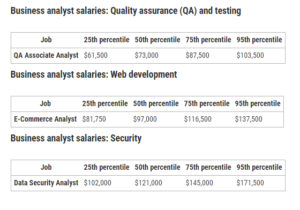Business analysts are responsible for bridging the gap between IT and the business using data analytics to assess processes, determine requirements and deliver data-driven recommendations and reports to executives and stakeholders.
The International Institute of Business Analysis (IIBA), a non-profit professional association, considers the business analyst “an agent of change,” writing that business analysis “is a disciplined approach for introducing and managing change to organisations, whether they are for-profit businesses, governments, or non-profits.”
The business analyst position requires both hard skills and soft skills. Business analysts need to know how to pull, analyse and report data trends, and be able to share that information with others and apply it on the business side. Not all business analysts need a background in IT as long as they have a general understanding of how systems, products and tools work. Alternatively, some business analysts have a strong IT background and less experience in business, and are interested in shifting away from IT to this hybrid role.
Core business analyst responsibilities
BAs engage with business leaders and users to understand how data-driven changes to process, products, services, software and hardware can improve efficiencies and add value. They must articulate those ideas but also balance them against what is technologically feasible and financially and functionally reasonable. Depending on the role, you might work with data sets to improve products, hardware, tools, software, services or process.
Identifying and then prioritising technical and functional requirements tops the business analyst’s list of responsibilities, says Bob Gregory, a professor and academic programme director for the business analysis and management degree programme at Bellevue University.
“Elicitation of requirements and using those requirements to get IT onboard and understand what the client really wants, that’s one of the biggest responsibilities for BAs. They have to work as a product owner, even though the business is the product owner,” Gregory says.
“[They need to ask:] What do the systems need to do, how do they do it, who do we need to get input from, and how do we get everyone to agree on what we need to do before we go and do it? The BA’s life revolves around defining requirements and prioritising requirements and getting feedback and approval on requirements,” says Jeffrey Hammond, vice president and principal analyst at Forrester Research.
The role of a business analyst is constantly evolving and changing – especially as companies rely more on data to advise business operations. Every company has different issues that a business analyst can address, whether it’s dealing with outdated legacy systems, changing technologies, broken processes, poor client or customer satisfaction or siloed large organisations.
Business analyst skills
According to the IIBA some of the most important skills and experience for a business analyst are:
- Oral and written communication skills
- Interpersonal and consultative skills
- Facilitation skills
- Analytical thinking and problem solving
- Being detail-oriented and capable of delivering a high level of accuracy
- Organisational skills
- Knowledge of business structure
- Stakeholder analysis
- Requirements engineering
- Costs benefit analysis
- Processes modelling
- Understanding of networks, databases and other technology
Business analyst salaries
Business analysts work in several industries and departments. Below are some of the most common analyst-related job titles in IT, according to the 2018 Salary Guide from Robert Half Technology. Robert Half Technology breaks out salary averages by experience, skills, complexity of the role and how competitive the location or industry is.
Entry-level workers typically fall in the 25th percentile, while those in the middle of their careers or those working in competitive or more complex roles typically fall within the 50th to 75th percentile. The 95th percentile are the most senior analysts or those working in the most competitive industries or in roles with a lot of complexity.
Entry-level workers typically fall in the 25th percentile, while those in the middle of their careers or those working in competitive or more complex roles typically fall within the 50th to 75th percentile. The 95th percentile are the most senior analysts or those working in the most competitive industries or in roles with a lot of complexity.
Business analyst training and education
The business analyst role requires a mix of IT and business skills. To succeed, business analysts need to understand how to work with data, while also analysing how it will impact the business. And, as a business analyst, once you uncover trends, you’ll need to know how to explain them to non-technical employees in the organisation.
Whether you need to brush up on your business knowledge or your IT skills, there are plenty of options for advancing your BA education, including certifications, boot camps and master’s programmes, outlined below.
Certifications
Although business analysis is a relatively new discipline in IT, a handful of organisations already offer certifications to help boost your resume and prove your merit as an analyst. Organisations such as the IIBA, IQBBA, IREB and PMI each offer their own tailored certification for business analysis. These include:
- IIBA Entry Certificate in Business Analysis (ECBA)
- IIBA Certification of Competency in Business Analysis (CCBA)
- IIBA Certified Business Analyst Professional (CBAP)
- IQBBA Certified Foundation Level Business Analyst (CFLBA)
- IREB Certified Professional for Requirements Engineering (CPRE)
- PMI-Professional in Business Analysis (PBC) Certification
Boot camps
Unlike certifications, which are designed to prove the skills you already have, boot camps are designed to teach you new skills or improve your current skillset. Boot camps can be anything from traditional workshops held over the course of a few days or full-fledged, instructor-led courses that run for weeks or months at a time. No matter what your preferred learning style is, you can find a boot camp to suit your needs.
Courses are often offered both in-person and online; alternatively, your organisation might bring a boot camp to the company to run a four-day workshop. Some boot camps are free, while others might require a subscription fee or a one-time fee that ranges from $100 to $2,500, depending on the programme. They’re all designed to give hands-on experience and help you build your resume and portfolio — some even offer career guidance and mentorship.
To find a business analyst boot camp that will fit your schedule, budget and skillset, see “10 boot camps for business analysts.”
Master’s programmes
If you have a computer science or business degree, you might want to look at a master’s in business analysis. Exactly what type of degree you go for will depend on what area of BA or IT you want to work in, but there are plenty of programmes designed to give you a formal business analyst education.
Tools and software
Business analysts typically rely on software such as Microsoft Excel, Microsoft PowerPoint, Microsoft Access, SQL, Google Analytics and Tableau. These tools help BAs collect and sort data, create graphs, write documents and design visualisations to explain the findings. You won’t necessarily need programming or database skills for a business analyst position, but if you already have these skills, they won’t hurt. The type of software and tools you’ll need to use will depend on your job title and what the organisation requires.
BA’s role in software development
Business analysts use real-time user data and analytics programs to identify user trends, successful functions and potential user adoption problems with the applications. As data becomes more valuable to organisations, so do business analysts.
“One of the key values in the concept of the BA moving into being a product owner, as the whole line between IT and digital and software development and business shifts, is that this role has become more and more exciting,” says Kelly Emo, director of product and solutions marketing for application lifecycle and quality at HPE Software.
Given the expanding list of responsibilities put on the position, some organisations have created product manager positions that work with BAs or have teams of BAs reporting to them, Hammond says.
Similarly, the expansion and the faster, more iterative pace of software development has changed the timing of the BA’s involvement with a given development project. A BA working in a classic waterfall development environment is more heavily involved at the front end, when gathering, analysing and prioritising user requirements, before handing those off to developers and then moving on to another software development project. Meanwhile, BAs working on agile projects generally stay with the project through implementation and even through multiple releases.
Organisations often assign BAs to several projects at a time if the projects are small enough, or they may assign a BA to a single project if it is complex. Hammond notes that organisations also assign multiple BAs to very large software development projects. But some IT departments today are not involving their business analysts in all in-house application development projects, Emo says.
According to Emo, organisations are less likely to assign BAs to development work on new classes of applications such as mobile marketing apps and apps for temporary sales promotions “because they’re operating very lean or doing DevOps.”
“It’s all happening very rapidly in continuous delivery mode, and it’s data-driven and not [driven by] lengthy requirement documents. What I see today, especially in the digital first applications, like digital e-commerce, it’s not the traditional business analyst involved.”
On the other hand, BAs are almost universally used for the development of back-office applications and core business software products, where identifying and documenting requirements is particularly critical, Emo says.
“A lot of those applications are under a lot of regulations, so [organisations] need that BA interface to document and ensure compliance,” she says.
IDG News Service








Subscribers 0
Fans 0
Followers 0
Followers